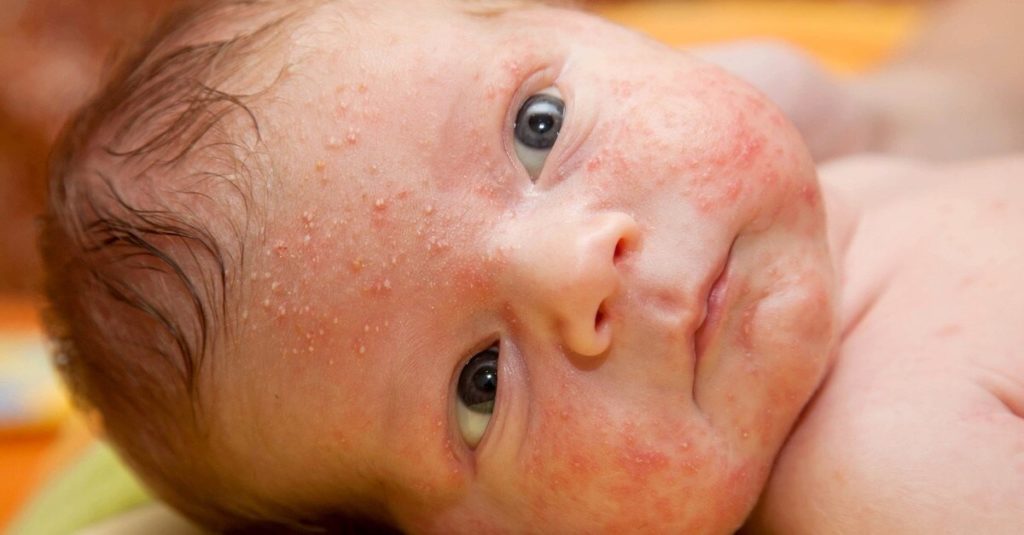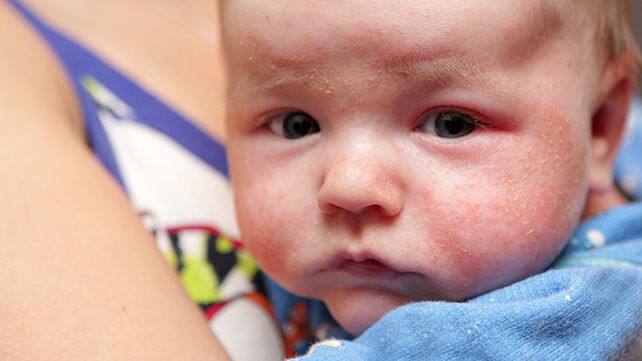Baby Acne
Acne on the face or body of a baby is a normal, typically temporary skin condition. Small red or white bumps or pimples appear as a result. Acne almost often clears up on its own without the need for care. Mommy and Dad do not be concerned. Newborn baby acne is exceptionally regular, despite how disturbing it can seem to new parents. There is also no reason to be worried; newborn baby acne is an entirely benign disease.

Acne in newborn babies usually occurs within the first month or so after birth, but it may develop sooner or later. Some babies also have a slight case of baby acne when they are born. Between weeks two and four, you may see an increase in breakouts. Neonatal acne is another name for baby acne. It affects about 20% of all newborns.
Baby acne differs from baby acne in that open Comedones, also known as blackheads, are rarely seen. These signs and symptoms are typical in children with acne. Acne in children may take the form of cysts or nodules. It can leave scars in rare cases if left untreated. Baby acne only appears within the first few months of your child’s life. Baby acne can last up to two years in children. Baby acne is far less common than adolescent acne.
WHAT CAUSES ACNE IN CHILDREN?
Acne appears in newborns during the first few weeks after birth. While some evidence indicates that baby acne is caused by an allergic response to skin colonization with Malassezia species, others believe it is caused by hormones transferred from mother to child during the last pregnancy stage. 1
Baby acne may be caused by milk, formula, or spit-up meeting a baby’s fragile skin. Rough fabrics or fabrics that have been washed in a strong detergent may irritate sensitive skin and exacerbate the appearance of baby acne.
If your baby has acne, consult your doctor about which soaps, lotions, or creams to use because some can irritate the skin.
An acne-like rash can also be caused by some drugs, viral illnesses, and allergic reactions. If your child develops a rash or an acne-like outbreak because of being sick or taking a new medication, contact your doctor immediately.
WHAT ARE THE SIGNS AND SYMPTOMS OF BABY ACNE?
Baby acne, like acne in children and adults, presents as red bumps or pimples. White pustules or whiteheads may appear, and the spots may be surrounded by reddish skin.
Also read: The Case Of Baby Fever Is Soaring High!
Acne can appear anywhere on a baby’s face, but it is most common on the cheeks. Acne on the upper back or neck of individual babies is also possible.
If your baby is fussy or crying, acne can become more noticeable. Rough fabrics, as well as vomit or saliva that remains on the face, can irritate acne.
Acne in babies may appear at any time after birth. However, it usually appears two to four weeks after birth. It can last for a few days or weeks, but it can last for months in some cases.
Newborn baby acne, also known as neonatal acne, looks eerily like acne you might have had as a teenager: Comedones (clogged pores), red papules, and probably small pustules which appear on your baby. Newborn acne may occur as a rough, bumpy red rash on some babies.
It usually occurs on a baby’s cheeks and nose, but it can occur anywhere on the face. Your baby’s back and shoulders can also break out. Baby acne can appear and disappear for several weeks, and it can be exacerbated when the baby is fussy or crying.
During the first few weeks of life, newborns are also susceptible to developing milia, and many babies are born with these blemishes. Milia appear on the skin as small white bumps, like pimples but without inflammation.
Milia are tiny cysts that are often lumped into the acne breakout group. They occur when a small amount of skin oil gets trapped under the skin’s surface. Milia are safe and, like newborn baby acne, will go away without treatment in most cases.
If you have any doubts about whether your child has acne, you should consult your pediatrician. Many other typical baby skin disorders, such as eczema and heat rash, may look like baby acne.
WHAT ARE THE POSSIBLE CAUSES OF BABY ACNE?
Eczema, erythema toxicum, and milia are all similar diseases.
- Eczema:
It is one of the most common skin conditions. Red bumps on the forehead characterize eczema. It can even appear on your baby’s knees and elbows as he or she grows older. Eczema may become infected, resulting in a yellow, crusty appearance. As your baby crawls around and scrapes up their knees and elbows, the problem can worsen. Your doctor should be able to tell the difference between baby acne and eczema with ease.
- Atopic dermatitis:
It is the most common form of eczema. Baby acne is the most common misdiagnosis for seborrheic eczema. Crib, or cradle, a cap is another name for seborrheic dermatitis.
Over-the-counter (OTC) products like Aquaphor and Vanicream can help with eczema. It’s also possible that a mild medicine would be administered.
You may also be asked to get rid of food allergens from your house and offer your baby probiotics regularly.
- Toxicum Erythematosus
Another common skin condition is erythema toxicum, which manifests as a rash, small bumps, or red blotches. The first few days after birth, it can be seen on your baby’s face, chest, or limbs.
It’s completely harmless, and it usually goes away within a week of birth.
- Milia
Milia are small white bumps that can appear on the face of your newborn. They emerge within a few weeks of birth as dead skin cells get trapped in tiny pockets of skin. Milia has little to do with baby acne and does not need to be handled.
WHAT IS THE PROCEDURE FOR BABY ACNE?
Acne in babies typically goes away on its own. Some babies have acne that lasts months rather than weeks. Your baby’s pediatrician may prescribe a medicated cream or ointment to help clear up this persistent type of baby acne.
You are using over-the-counter acne remedies, face washes, and lotions sparingly. At this age, your baby’s skin is susceptible. Using anything too strong may aggravate the acne or cause additional skin irritation.
There is no need to treat your baby’s acne unless an underlying illness triggers it. Newborn acne does not harm your baby and is strictly a cosmetic problem.
What your baby’s skin needs is a gentle wipe down once or twice a day with clear water. Don’t wipe or use soap on your baby’s face. Excessively regular or intensive cleansing can irritate your baby’s sensitive skin.
Extreme baby acne is only treated with topical acne treatments in the most severe cases. However, since acne treatments are harsh on babies’ delicate skin, this can only be done if there is an excellent reason to do so and foremost on your child’s doctor’s advice.
BABY ACNE VS. NEWBORN ACNE
It’s important to remember that acne in a newborn differs significantly from acne in an older baby. Around the age of six weeks, baby acne will occur. It is not as common as newborn baby acne, but it lasts much longer, anywhere from a few months to several years. Baby acne, like newborn baby acne, is usually harmless and goes away on its own.
However, it can cause scarring in certain severe cases, which can be treated with prescription drugs. Please bring your child’s acne to your pediatrician’s attention whether he or she is older.
CAN HOME TREATMENTS FOR BABY ACNE BE USEFUL?

There are things you can do to help keep your baby’s skin as safe as possible while you wait for the acne to clear up.
- Make sure your baby’s face is clean: Hot water can be used to wash your baby’s face regularly. This is a beautiful time to do it in the bath. You don’t need to use anything other than water, but if you want to, mild soap or soap-free cleanser will suffice. Do not be afraid to seek advice from your child’s pediatrician.
- Stay away from harsh goods: Adult acne is usually treated with retinoids, which are like vitamin A or erythromycin. They are not, however, necessarily recommended for babies.Avoid using scented soaps, bubble wash, or any other soaps that contain a lot of chemicals.
- Do not use lotions: Lotions and creams can irritate your baby’s skin, exacerbating acne.
- Avoid scrubbing: Scrubbing the skin with a towel will irritate it even more. Instead, gently wipe your face with a washcloth in circular movements. Once you’ve washed off the cleanser, wipe your baby’s face dry with a towel.
- Avoid squeezing: Avoid rubbing or pinching the acne. This can irritate your baby’s skin, making the issue worse.
- Have patience: Acne in babies is usually painless. Your baby would not be itchy or in pain. It can resolve on its own quickly.
WHEN DO YOU SEEK MEDICAL ATTENTION FOR BABY ACNE?
While there is no cure for baby acne, you can still see a pediatrician if you’re concerned. A well-baby appointment or general checkup is an excellent opportunity to ask questions about baby acne and address any other health issues you might have.
If your child’s acne causes blackheads, pus-filled bumps, or inflammation, see a doctor immediately. A visit to the doctor can also be prompted by pain or discomfort.
If your child’s acne persists after several months of home care, the doctor can prescribe a 2.5 percent benzoyl peroxide lotion.
They can also prescribe an antibiotic, such as erythromycin or isotretinoin, in rare cases to prevent your baby from developing permanent scars. This usually is only required for severe acne caused by an underlying medical condition in children.
While baby acne does not recur, it is essential to remember that if your child develops acne before reaching puberty, they should see their doctor because this may indicate an underlying issue.
UNDERLYING CIRCUMSTANCES
Acne that does not lead to home treatment may be due to several rare conditions. Tumors, the adrenal disorder congenital adrenal hyperplasia (CAH), and other endocrine system disorders are among them.
Ask your doctor to look for underlying problems if your baby girl begins to show symptoms of hyperandrogenism. Overgrowth of facial hair or excessively oily skin are two possible symptoms.
FINAL COMMENTS:
In just a few weeks, almost all cases of newborn baby acne disappear without medication. Bring it up with your pediatrician, so don’t be concerned about acne. Even with a few pimples, your cute little one is lovely and beautiful. Take advantage of these precious first months with your new kid!

